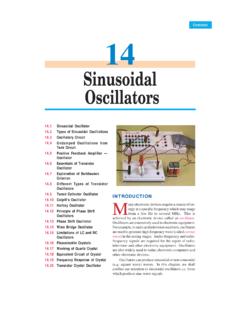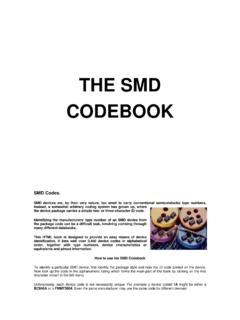Transcription of CONTENTS
1 This eBook shows you how to TEST COMPONENTS. To do this you need "TEST GEAR." The best item of Test Gear is a MULTIMETER. It can test almost 90% of all components. And that's what we will do in this eBook:CONTENTSA nalogue MultimeterAudio StagesBatteries- testingBurnt ResistorBuying A MultimeterCapacitorsCapacitors -decoupling capsCapacitors in ParallelCapacitor Substitution BoxCells- batteriesCircuit SymbolsCo-Ax CablesColour Code (Resistor)CoilsContinuity Creating any value of RMultimetersNon-polar Capacitor (electrolytic)Open Circuit"Open" Resistor- damagedOpto-couplersParallel- resistorsParallel and Series Capacitors Piezo Diaphragms Piezo BuzzersPotentiometersPots- testing Power DiodesPower Supply -see Basic Electronics 1A Reed SwitchRelaysRemote ControlsCurrent - measuringCurrent Sensing ResistorsCurrent TransformerDamper DiodesDarlington TransistorsDigital ChipsDigital MultimeterDigital TransistorsDiodes replacing a diodeDischarge a CapacitorEarth Leakage DetectorsElectrolyticsFETsFingers- to feel temperatureFocus pots Fuses and 100mA fusesGermanium DiodesHeatsinksImpedance- of a stageIC's- also called digital ChipsIC's- Analogue Chips"In-Circuit"
2 TestingInductorsInductors- measuring Integrated CircuitsIsolation TransformerLatching Reed SwitchLEDsLogic Probe MkIIB Logic Probe- SimpleLogic Probe - using CD4001 Logic Probe - using CD4011 Making your own componentsMeasuring ResistanceMeasuring VoltageMica Washers and InsulatorsMotor- testing MOSFETsResistor Colour CodeResistor NetworksResistors- seriesResistor Substitution BoxRipple FactorSchottky DiodesSCRsShort CircuitSignal InjectorSilicon diodesSolderingSpark GapsSpeakerSubstitution BoxSuper Probe MkIISurface Mount- PacksSurface-Mount ResistorsSurface-Mount Resistor MarkingsSwitchesSymbolsTest EquipmentTesting A CircuitTesting A ResistorTesting Components "In-Circuit"Transformers- current transformerTransformer Ratings 28v-0-28vTransistor OutlinesTransistorsTransistors DigitalTriacsUnknown resistors- testingUsing A MultimeterVoltage DividerVoltage RegulatorsVoltages on a circuitWire Wound ResistorYokesZener Diodes4-Band Resistors5-Band Resistors10-Turn PotsUse your "brain, knowledge and your fingers.
3 "Before we start, fixing anything is a combination of skill, luck and good diagnosis. Sometimes you can fix something by letting it run until it finally fails. Some things start to work as soon as you touch them. Some things can never be fixed. But some things can be fixed by feeling the temperature rise and deciding if it is getting too hot. Sometimes you can smell something getting too hot. Sometimes you can see SMOKE. All these things make you a very clever technician and about 50% of faults will be fixed by looking for dry joints, burnt parts, overheating and carefully inspecting an item before you disturb it. By simply touching different items you can quite often feel a hot item and home-in on the fault - at a saving of hours of work.
4 Servicing is not "A bull at a gate" approach. You may be able to service something by turning it on and leaving it for hours - and start thinking. It may take you a day to come up with the answer. Believe me. That's how it worked for me - while fixing over 35,000 TV's. TEST EQUIPMENTE veryone thinks TEST EQUIPMENT will "solve the problem."This is a big big MISTAKE. Test equipment can help solve a problem and it can "lead to frustration," "give an incorrect answer," "mess you up," and make things worse. You have to be very careful with test equipment and especially EXPENSIVE equipment because it is very sensitive and can detect pulses and glitches and voltages that are not affecting the operation of the circuit.
5 You will learn a lot of tricks when reading through this article, but let me say two things. There are lots of faults and components that you cannot test with "test equipment" because they are either intermittent or the equipment does not load the device to the same extent as the circuit. And secondly you need both an ANALOGUE multimeter and a digital meter to cover all the situations. And if you are working on a car, you only need a $ analogue meter because it will be dropped or fall into a crack, and you will only lose $ will learn that a digital meter will pick up spikes and signals on a line and show an incorrect reading. That's why you need to back-up your readings with an analogue meter.
6 When you charge a battery it gets a "floating voltage" and this will be higher than the actual voltage, when the battery is fitted to a project. An analogue meter will draw a slight current and remove the "floating voltage." Component testers can also give you a false reading, either because the component is out of range of the tester or intermittent and you need to be aware of this. Oscilloscopes can also display waveforms that are parts of glitches or noise from other chips and these do not affect the operation of the part of the circuit you are investigating. Sometimes you cannot pickup a pulse because it is not regular and the trigger on the oscilloscope does not show it on the screen.
7 You may think it is missing. It all depends on the "speed of the oscilloscope" - it's maximum frequency of operation. Lastly- Power Supplies. You cannot test globes and motors on a power supply because the starting current can be 5 times more than the operating current. The power supply may not be able to deliver this high current and thus you will think the motor or globe is faulty. MULTIMETERST here are two types: digital and ANALOGUEA digital Multimeter has a set of digits on the display and an Analogue Multimeter has a scale with a pointer (or needle). You really need both types to cover the number of tests needed for designing and repair-work. We will discuss how they work, how to use them and some of the differences between AND ANALOGUE MULTIMETERSBUYING A MULTIMETERT here are many different types on the cost is determined by the number of ranges and also the extra features such as diode tester, buzzer (continuity), transistor tester, high DC current and most multimeters are reliable and accurate, buy one with the greatest number of ranges at the lowest article explains the difference between a cheap analogue meter, an expensive analogue meter and a digital meter.
8 You will then be able to work out which two meters you should buy. Multimeters are sometimes called a "meter", a "VOM" (Volts-Ohms-Milliamps or Volt Ohm Meter) or "multi-tester" or even "a tester" - they are all the A MULTIMETERA nalogue and digital multimeters have either a rotary selector switch or push buttons to select the appropriate function and range. Some digital Multimeters (DMMs) are auto ranging; they automatically select the correct range of voltage, resistance, or current when doing a test. However you need to select the making any measurement you need to know what you are checking. If you are measuring voltage, select the AC range (10v, 50v, 250v, or 1000v) or DC range ( , , 10v, 50v, 250v, or 1000v).
9 If you are measuring resistance, select the Ohms range (x1, x10, x100, x1k, x10k). If you are measuring current, select the appropriate current range DCmA , 50mA, 500mA. Every multimeter is different however the photo below shows a low cost meter with the basic most important point to remember is this:You must select a voltage or current range that is bigger or HIGHER than the maximum expected value, so the needle does not swing across the scale and hit the "end stop."If you are using a DMM ( digital Multi Meter), the meter will indicate if the voltage or current is higher than the selected scale, by showing "OL" - this means "Overload." If you are measuring resistance such as 1M on the x10 range the "OL" means "Open Loop" and you will need to change the range.
10 Some meters show "1' on the display when the measurement is higher than the display will indicate and some flash a set of digits to show over-voltage or over-current. A "-1" indicates the leads should be reversed for a "positive reading." If it is an AUTO RANGING meter, it will automatically produce a reading, otherwise the selector switch must be changed to another range. The Common (negative) lead ALWAYS fits into the "COM" socket. The red lead fits into the red socket for Voltage and Resistance. Place the red lead (red banana plug)into "A" (for HIGH CURRENT "Amps") or mA,uA for LOW black "test lead" plugs into the socket marked "-" "Common", or "Com," and the red "test lead" plugs into meter socket marked "+" or "V-W-mA.















